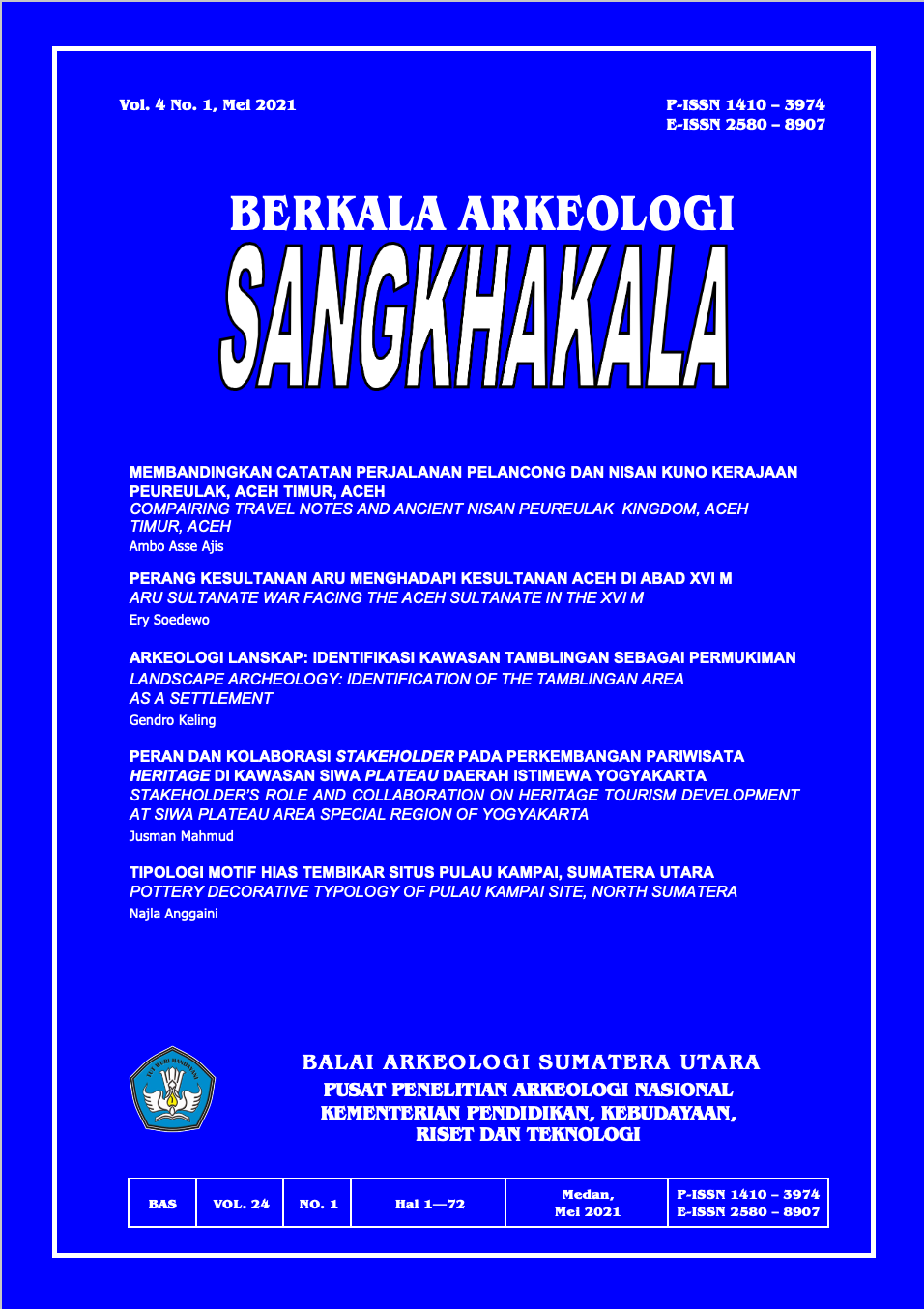TIPOLOGI MOTIF HIAS TEMBIKAR SITUS PULAU KAMPAI, SUMATERA UTARA [Pottery Decorative Typology of Pulau Kampai Site, North Sumatera]
Main Article Content
Abstract
Pottery is a human creation in the form of objects or containers made of clay which are burned at a burning temperature of 3500C-10000C. The pottery tradition began to be discovered during the cultivation period, in Indonesia pottery became known around 6000 BC, since then pottery has become one of the most important tools in human life. Pottery artifacts are often found at archaeological sites, either intact or in fragments. From the pottery data, there are several aspects that can be studied both in terms of form, decoration and function. The method used in this research is in the form of a special analysis, namely, by observing the attributes of decorative motifs on pottery at the Kampai Island Site, North Sumatra. The data used in this study were the findings of pottery from the excavation of the North Sumatra Archeology Center in 2013. The total number of pottery analyzed in total amounted to 974 shards. The purpose of this study was to determine the typology of decorative pottery motifs at the Kampai Island Site. The results of the research on the analysis of Kampai Island pottery motifs show that there are various decorative motifs so that the classification process of pottery decorative motifs is carried out which can produce several types or typologies of pottery decorative motifs in the Kampai Island Site, namely the types of motifs of lines, squares, circles, and triangles.
Tembikar merupakan suatu hasil karya cipta manusia berupa benda atau wadah yang terbuat dari tanah liat yang dibakar pada suhu pembakaran 3500 C-10000 C. Tradisi tembikar mulai ditemukan pada masa bercocok tanam, di Indonesia tembikar mulai dikenal sekitar 6000 SM, yang sejak saat itu tembikar menjadi salah satu alat perlengkapan yang penting di kehidupan manusia. Artefak tembikar sering ditemukan pada situs arkeologi, baik utuh maupun pecahan. Data tembikar juga dapat diteliti dari beberapa aspek baik dari segi bentuk, hiasan maupun fungsi. Metode yang digunakan dalam penelitian ini berupa Analisis Khusus yaitu, dengan mengamati atribut motif hias pada tembikar Situs Pulau Kampai, Sumatera Utara. Data yang digunakan pada penelitian ini berupa temuan tembikar dari hasil ekskavasi Balai Arkeologi Sumatera Utara tahun 2013. Jumlah tembikar yang dianalisis secara keseluruhan berjumlah 974 pecahan. Adapun tujuan penelitian ini untuk mengetahui tipologi motif hias tembikar Situs Pulau Kampai. Hasil penelitian analisis motif hias tembikar Pulau Kampai menunjukan bahwa terdapat motif hias yang beragam sehingga dilakukan proses klasifikasi motif hias tembikar yang dapat menghasilkan beberapa tipe-tipe atau tipologi motif hias tembikar Situs Pulau Kampai, yaitu tipe motif garis, kotak, lingkaran, dan segitiga.
Downloads
Article Details
References
Atmosudiro, Sumijati, 1994. Gerabah prasejarah di Liang Bua, Melolo dan Lowoleba. Tinjauan teknologi dan fungsi. (Disertasi), Yogyakarta: Fakultas Ilmu Budaya, Universitas Gadjah Mada.
Clarke, D.L , 1978. Analytical Archaeology, New York: Columbia.
Deetz, James. 1967. Invitation to Archaeology. American Museum ScienceBook.Published for The American Museum of Natural History. New York: The Natural History Press.
Eriawati, Yusmaini, 2004. Pola Hias Tembikar dari Situs Karang Agung Musi Banyu Asin (Muba), Sumatera Selatan. (Amerta Berkala Arkeologi: Pusat Penelitian dan Pengembangan Arkeologi Nasional
Koentjaraningrat. 2009. Pengantar Ilmu Antropologi. Cetakan ke 8. Jakarta: P. T Rinike Cipta.
Rangkuti, Nurhadi& Pojoh, Inggrid H. E. 2008.Buku Panduan Analisis Keramik. Jakarta: Pusat Penelitian Arkeologi Nasional.
Sharer, Robert J & Wendy Ashmore. 1992. Archaeology Discovering Our Past (2nd.ed) California: Mayfield publishing company
Soedewo, Ery, 2013. “Perkembangan Penelitian Kepurbakalaan di Pulau Kampai, Sumatera Utara” dalam Archipel 86. Paris: Association Archipel EHESS
Soejono, R.P. 2008. Sejarah Nasional Indonesia 1. Jakarta: Balai Pustaka.
Sukendar, Haris Dkk, Metode Penelitian Arkeologi.1999.Jakarta: Departemen Pendidikan Nasional Pusat Penelitian Arkeologi Nasional.
Tanudirdjo, Daud Aris. 1989. “Ragam Metode Penelitian Arkeologi dalam Skripsi Karya Mahasiswa Arkeologi Universitas Gadjah Mada”, Yogyakarta: Fakultas Ilmu Budaya, Universitas Gadjah Mada.
Wahyudi, Wanny ,Rahardjo, 2012. Tembikar Upacara di Candi – Candi Jawa Tengah Abad ke 8- 10. (Jakarta: Wedatama Widya Sastra)


